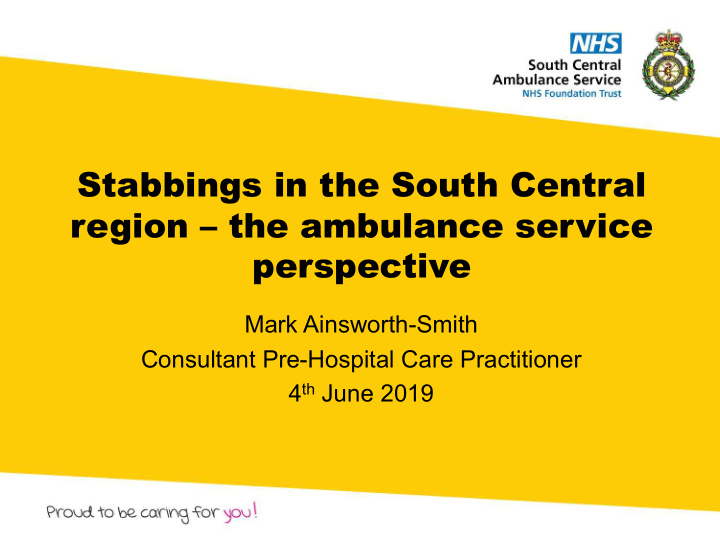



Stabbings in the South Central region – the ambulance service perspective Mark Ainsworth-Smith Consultant Pre-Hospital Care Practitioner 4 th June 2019
My brief was to identify: • Where are the ‘hot spots’ in the patch? • What responses are needed?
The SCAS ‘footprint’ Population 4 million 3
Background Since November 2016, SCAS have been using electronic patient records (ePR). This gives us the ability capture huge amounts of very accurate data which includes: • Hot spot areas • Common mechanisms of injury (i.e. RTC, stabbings etc) • Demographics, including ‘at risk’ age groups
Original methodology • We did a search of all of our ePR records looking for ‘stabbing’ in the free text • 3 years worth of data (approximately 1.5 million records) from April 2016 to March 2019……..
On the face of it SCAS appeared to have the highest number of stabbings in the UK (circa 47k) Strangely it was our over 65’s who were most at risk of being stabbed……
In fact Our ePR data was flawed. If a patient complained of ‘stabbing chest pain’ then they were captured in the stabbing data……..
Revised methodology Chief complaint ePR search: • Trauma AND Free text ePR search on: • Weapon used • Bladed implement • Knife • Stabbed • Attacked • ‘Stabbing’ removed All calls from 111 were excluded
Stabbing Data The following information is based on our ePR data with the revised search….
Who is affected by stabbing?
Demographics
Where do stabbings occur?
‘Stabbing’ Map shows demand identified as potential stabbing between Apr ‘16 & Mar ’19. 86% of our stabbings occur in our urban areas Demand by local authority
Reading Map filtered to show: Fri-Sun 21:00 – 00:00
Portsmouth Map filtered to show: Fri-Sun 21:00 – 00:00
Milton Keynes Map filtered to show: Fri-Sun 21:00 – 00:00
Hot spots • Taxi ranks • Fast food outlets • Pubs + clubs • Police stations • Walk in centres
When do stabbings occur?
Day/Time Profile
Local Authority Differences Southampton Local Authority Profile Milton Keynes Local Authority Profile
What responses are required?
Responses that are needed: The initial management of a patient with stab wounds is absolutely (time) critical: We can directly improve patient care by: • ‘Dispatch modelling’ to ensure that the right resources are available to be sent – as quickly as possible • Appropriately using our critical care assets • Additional training in ‘hotspot’ areas – including ambulance, police and hospital staff
But even more important than the medical care, is preventing stabbings from occurring in the first place…….
Collaborative working - Prevention Better working with our partner agencies which includes: – Police – Emergency departments – Security staff – Youth workers – Voluntary sectors We also need to change the culture……
Demand trend
Conclusion • Based on our SCAS data, stabbing is an increasing problem • We need to work collaboratively • We know who , where , and when people are affected by stabbing – now let’s do something to stop it………
Thank you to: • Vivienne Parsons – SCAS Specialist Business Intelligence Analyst • Phil King – SCAS Senior Analyst / Clinical
Any questions?
Recommend
More recommend